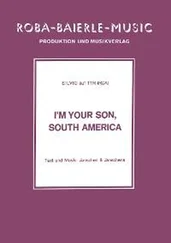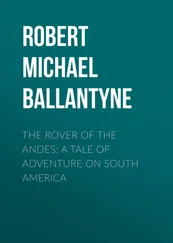James Bryce Bryce - South America Observations and Impressions
Здесь есть возможность читать онлайн «James Bryce Bryce - South America Observations and Impressions» — ознакомительный отрывок электронной книги совершенно бесплатно, а после прочтения отрывка купить полную версию. В некоторых случаях можно слушать аудио, скачать через торрент в формате fb2 и присутствует краткое содержание. Жанр: foreign_antique, foreign_prose, на английском языке. Описание произведения, (предисловие) а так же отзывы посетителей доступны на портале библиотеки ЛибКат.
- Название:South America Observations and Impressions
- Автор:
- Жанр:
- Год:неизвестен
- ISBN:нет данных
- Рейтинг книги:3 / 5. Голосов: 1
-
Избранное:Добавить в избранное
- Отзывы:
-
Ваша оценка:
- 60
- 1
- 2
- 3
- 4
- 5
South America Observations and Impressions: краткое содержание, описание и аннотация
Предлагаем к чтению аннотацию, описание, краткое содержание или предисловие (зависит от того, что написал сам автор книги «South America Observations and Impressions»). Если вы не нашли необходимую информацию о книге — напишите в комментариях, мы постараемся отыскать её.
South America Observations and Impressions — читать онлайн ознакомительный отрывок
Ниже представлен текст книги, разбитый по страницам. Система сохранения места последней прочитанной страницы, позволяет с удобством читать онлайн бесплатно книгу «South America Observations and Impressions», без необходимости каждый раз заново искать на чём Вы остановились. Поставьте закладку, и сможете в любой момент перейти на страницу, на которой закончили чтение.
Интервал:
Закладка:
The interior of the Culebra Cut presented, during the period of excavation, a striking sight. Within the nine miles of the whole cutting, two hundred miles of railroad track had been laid down side by side, some on the lowest level on terraces along which the excavating shovels were at work. Within the deepest part of the cutting, whose length is less than a mile, many hundreds of railroad construction cars and many thousands of men were at work, some busy in setting dynamite charges for blasting, some clearing away the rubbish scattered round by an explosion, some working the huge moving shovels which were digging into the softer parts of the hill or were removing the material loosened by explosions, the rest working the trains of cars that were perpetually being made up and run out of the cutting at each end to dump the excavated material wherever it was needed somewhere along the line of the Canal. Every here and there one saw little puffs of steam, some from the locomotives, some where the compressed air by which power was applied to the shovels was escaping from the pipes, and condensing the vapour-saturated atmosphere.
There is something in the magnitude and the methods of this enterprise which a poet might take as his theme. Never before on our planet have so much labour, so much scientific knowledge, and so much executive skill been concentrated on a work designed to bring the nations nearer to one another and serve the interests of all mankind.
Yet a still more interesting sight is that which meets the visitor when, emerging from the cutting, he crosses to where, behind the western hill, are the quarters of the workers, 6with the cottages of the chief engineer and his principal assistants on the top. The chief engineer, Colonel Goethals, is the head not only of the whole scheme of construction but of the whole administration, and his energy, judgment, and power of swift decision are recognized to have been a prime factor in the progress of the work and the excellence of the administrative details. The houses, erected by the United States government, are each of them surrounded on every floor by a fine wire netting which, while freely admitting the air, excludes winged insects. All the hospitals have been netted so carefully that no insect can enter to carry out infection from a patient. Every path and every yard is scrupulously clean and neat. Not a puddle of water is left where mosquitoes can breed, for every slope and bottom has been carefully drained. Even on the grass slopes that surround the villas at Ancon there are little tile drains laid to carry off the rain. With the well-kept lawns and the gay flower-beds, the place has the air of a model village. And one sees the same in the other quarters of the employés all along the canal line, at Gatun, at Miraflores, at Ancon, where is the great hospital and where have been set up the offices of the civil government which does everything for its employés, both white and coloured. Nowhere perhaps in the world are workpeople so well cared for, and such ample and almost luxurious provision made for comfort and amusement as well as for health by the benevolent autocracy which presides over everything. Its success in escaping all charges of partiality or corruption, as well as in producing efficiency in the work and contentment among the workers, has indeed been such as to make some persons draw from it an argument in favour of State control of all great enterprises. To the unbiassed observer it is rather an instance of the efficiency obtainable by vesting full administrative control in men whose uprightness and capacity have already been proved beyond question, who have not risen by political methods, and who have nothing to gain by any misuse of their powers. So far as any political moral can be drawn from the case, that moral recommends not democratic collectivism but military autocracy.
In these wire nettings and drainage arrangements and hospital precautions, to which I have referred, more than in anything else is to be found the reason why, after the French effort to build the canal had twice failed, the present enterprise is succeeding. The French engineers had shown great skill and were doing their work well. No one admits their merits more fully than do, with the generous candour that belongs to true soldiers and true men of science, the American engineers who have come after them. But they had no means of fighting the yellow fever and the malaria that were frustrating all their skill and exhausting all their resources. The discovery, made while the United States troops were occupying Cuba after the war of 1898, that yellow fever is due to the bite of the Stegomyia carrying infection from a patient to a healthy person, and that intermittent fevers are due to the bite of the Anopheles , similarly bearing poison from the sick to the sound, made it possible to enter on a campaign for the prevention of these diseases among the workers on the Isthmus. This was done before excavation began, and done so efficiently that the Isthmus is now as healthy as any part of the United States. No case of yellow fever has occurred since 1905. The mortality is no higher than in the United States army generally. In 1910 the death rate among 50,802 employés of both colours in the Canal Zone was 10.98 per thousand, in 1911, among 48,876, it was 11.02, – an extraordinarily low rate when compared with the average of European and North American cities. Among the American white employés and their families the rate was only 6.01. 7The white employés and their families are healthy and fresh-looking, with none of that sickly brownish-yellow hue which usually marks the inhabitants of malarial districts. And I can confirm what many other visitors have told me, that one may be for days and nights on the Isthmus and neither see nor hear nor feel a mosquito. To have made one of the pest-houses of the world, a place with a reputation like that of the Pontine Marshes, or Poti on the Black Sea, or Sierra Leone itself, as healthy as Boston or London is an achievement of which the American medical staff, and their country for them, may well be proud; and the name of Colonel Gorgas, the head of that medical staff to whose unwearied zeal and care this achievement is largely due, deserves to stand on the roll of fame beside that of Colonel Goethals, the chief engineer and Chairman of the Commission, who has directed, and is bringing to its successful issue, this whole great enterprise.
The sanitation of the Canal Zone, following that of Havana, has done more than make possible the piercing of the Isthmus. It has opened up possibilities for the settlement by Europeans of, and for the maintenance of permanent European population in, many tropical districts hitherto deemed habitable by their natives only. To the effect of such an example one can hardly set bounds.
In no previous age could an enterprise so vast as this have been carried through; that is to say, it would have required a time so long and an expenditure so prodigious that no rational government would have attempted it. Pharaoh Necho may have, as Herodotus relates, dug a canal across the Isthmus of Suez by the labour of hundreds of thousands of his subjects accustomed to implicit obedience, but his ditch was probably a small and shallow one, and it was through a dead level of sand and clay that it was dug. Here there was a mountain to pierce and a torrent to bridle, and the locks had to provide for vessels a thousand feet long. Nothing but the new forces which scientific discovery has placed in the hands of the modern engineer – steam, electricity, explosives of high power, machinery capable of raising and setting in their place one above another huge masses of cement – would have made the work possible. Yet even that was not enough. The French company possessed such appliances, and though their estimates of cost turned out to be based on totally inadequate data, the competence and energy of their engineers have never been questioned. And the French company failed hopelessly; and failed not merely because the work turned out heavier, and the loose strata giving way under the downpours of rain made the slides and landslips far worse, than was expected. 8These things doubtless told against them, and much of the money raised never found its way to the Isthmus. But it was a more terrible force that foiled them. It was Pestilence, Pestilence coming on the gauzy wings of the mosquito. So little did they recognize their foe that when they built the large and commodious hospital at Ancon they provided, outside the windows, flower-boxes where stagnant water gathered and mosquitoes were hatched. Engineers died, foremen died, labourers were mown down by hundreds. Yet even if all the French capital had been properly spent and better sanitary measures had reduced the pestilential conditions, it may be doubted whether the French company could have made a success of the undertaking. More capital would have been needed, capital which must have been raised on onerous terms, and when it had all been spent and the work completed the profits of the canal could not, after providing for working expenses, have paid interest on half of the money borrowed. Whoever looks at this prodigious work feels that it could be carried through only by a nation commanding resources so overflowing that it does not need to care how much it spends, a nation which can borrow as much money as it pleases without sensibly affecting the quotations of its existing national debt.
Читать дальшеИнтервал:
Закладка:
Похожие книги на «South America Observations and Impressions»
Представляем Вашему вниманию похожие книги на «South America Observations and Impressions» списком для выбора. Мы отобрали схожую по названию и смыслу литературу в надежде предоставить читателям больше вариантов отыскать новые, интересные, ещё непрочитанные произведения.
Обсуждение, отзывы о книге «South America Observations and Impressions» и просто собственные мнения читателей. Оставьте ваши комментарии, напишите, что Вы думаете о произведении, его смысле или главных героях. Укажите что конкретно понравилось, а что нет, и почему Вы так считаете.












